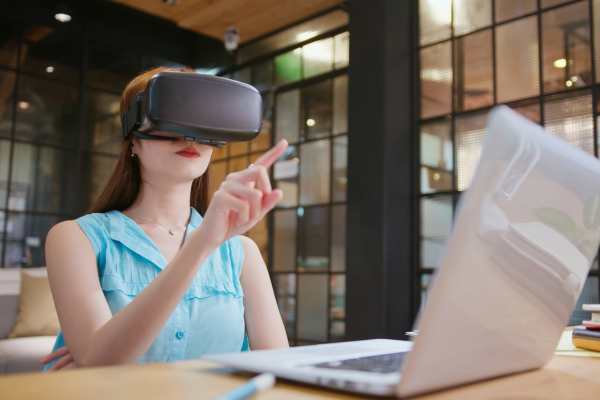.png)
The Digital Transformation of Architecture: A Closer Look at BIM and AR
Imagine a world where buildings almost build themselves, with robots and computers doing most of the heavy lifting. Sounds like something out of a sci-fi movie, right? Well, that future is closer than you might think. Today, we're seeing robots, augmented reality (AR), and something called Building Information Modeling (BIM) change the way we think about architecture. These tools aren't just making things faster; they're making design and construction more creative, more sustainable, and, believe it or not, more human.
In this blog, we're diving into how these technologies are shaping the future of architecture. From robots that can lay bricks to software that lets you walk through a building before it's even built, the possibilities are endless. And as we explore these futuristic tools, we'll see not just how they're changing buildings, but how they're changing the people who make them. So, let's get started on this exciting journey into the future of architecture.
Robots in architecture? Yes, it's happening, and it's pretty cool. Think about those big, heavy tasks on a construction site. Now, imagine robots taking care of them. These aren't science fiction; they're real robots working today, helping build the places we live and work in.
Let's break it down. Some robots are like big, automated arms that can move things around or put pieces together. Others are more like drones, flying around, getting a bird's eye view of the construction site. They can do things really fast and keep going without getting tired. Plus, they're super precise, which means less waste and mistakes.
But it's not just about speed and precision. Robots are also making construction safer. Think about it: if a robot is doing the dangerous stuff, like working at great heights or lifting heavy stuff, people don't have to. That's a big deal.
Also, there's something kind of amazing about watching a robot work. They can do things in ways we never thought possible, opening up new ideas for what buildings can look like and how they can be made. Architects and builders are starting to dream up new designs, knowing robots can help turn those dreams into reality.
Sure, the idea of robots everywhere might seem a bit out there. But in architecture and construction, they're here, and they're making a big difference. It's an exciting time to see what they'll build next.

Now, let's talk about something called BIM, or Building Information Modeling. Imagine you're playing a video game where you design buildings. You can see everything: the walls, the wiring, even how the sunlight hits the rooms. BIM is kind of like that, but for real-life building projects. It lets architects and engineers see everything about a building before they even start building it.
With BIM, everyone working on a project can look at the same model and make changes in real time. It's like having a group chat for building a house, where everyone can share their ideas and updates instantly. This cuts down on surprises and mistakes because everyone's on the same page from the start.
But BIM isn't just about avoiding mistakes; it's about dreaming bigger. Because when you can see how everything fits together so clearly, you can try out new, creative ideas that might have seemed too risky or hard to imagine before. It's like having a safety net for innovation.
Also, BIM saves money and time. Changes can be made in the model before they become expensive mistakes on the construction site. Plus, BIM can even show how a building will use energy, helping make it more environmentally friendly.
In short, BIM is changing the game in architecture. It's not just a tool for drawing buildings; it's a way to make those drawings come to life more efficiently, creatively, and sustainably than ever before.
Augmented Reality (AR) is like magic glasses for architecture. Put them on, and you can see a building before it's built, right on the spot where it's going to be. It's not just in your imagination anymore; it's right there in front of you, mixed into the real world.
For architects and their clients, AR is a game-changer. Ever tried to read blueprints and felt lost? AR makes it easy. Instead of guessing what a space might look like, you can see it with your own eyes. Walk around a room, look out a window, even see how the light changes throughout the day. It's all possible with AR.
And it's not just about impressing clients. AR helps find problems before they happen. Maybe a door opens the wrong way, or there's not enough room to walk around a table. With AR, you can spot these issues early and fix them without wasting time or money.
In the end, AR is about making the process of designing and building spaces more interactive and intuitive. It's a tool that brings ideas to life, making sure the future we're building is exactly the one we've imagined.
Sustainability and efficiency are big deals in architecture today, and it's all about making buildings that are kind to our planet and smart with resources. Think of it like this: buildings that need less energy to keep you warm in winter or cool in summer. That's not just good for the earth; it's good for your wallet too.

With new tech like BIM and AR, architects can design buildings that fit perfectly into their environment. They can see how sunlight and wind will interact with their buildings. This means they can use less artificial lighting and heating, which saves energy.
But it's not just about energy. These tools help use materials more wisely, too. We can cut down on waste by knowing exactly how much material we need. Plus, with robots, we can build in ways that produce less pollution.
Imagine buildings that give back to the environment, like roofs covered in plants that clean the air. Or designs that collect rainwater for reuse. This isn't just a dream; it's becoming a reality thanks to these technologies.
So, when we talk about the future of architecture, it's not just about cool designs. It's about creating buildings that help our planet. And with every new project, we're getting better at it.
Looking ahead, the fusion of technology and architecture promises even more exciting changes. We're on the brink of seeing buildings that not only exist in harmony with nature but actively contribute to the well-being of our environment.
The role of robots, BIM, and AR will continue to evolve, pushing the boundaries of what's possible in design and construction. These tools will make building processes faster, safer, and less costly, while also opening up new avenues for creativity and innovation.
Moreover, the integration of smart technologies in buildings will enhance our living and working spaces, making them more responsive to our needs. As we look to the future, the possibilities are limitless.
As we step into the future, it's clear that the intersection of technology and architecture is reshaping our world. Robots, BIM, and augmented reality aren't just tools; they're the building blocks of a new era where design meets possibility.
These advancements promise not just smarter, safer, and more sustainable buildings, but a deeper connection between our spaces and the world around us. The future of architecture is bright, filled with potential for innovations that we've only begun to explore.
Together, we're not just constructing buildings; we're crafting the backdrop of our lives, ensuring a better, more exciting world for generations to come.
In wrapping up, it's evident that the blend of robots, BIM, and augmented reality is not just changing architecture; it's revolutionizing it. These innovations are making the impossible possible, crafting buildings that are not only more efficient and sustainable but also more in tune with human needs.
As we venture further into this new era, the promise of a smarter, greener, and more imaginative world of architecture unfolds before us. This journey into the future is not just about the buildings we create but about reimagining the very spaces we call home, ensuring they are places of innovation, comfort, and sustainability for all.